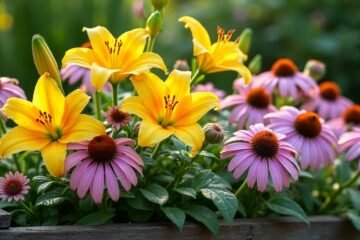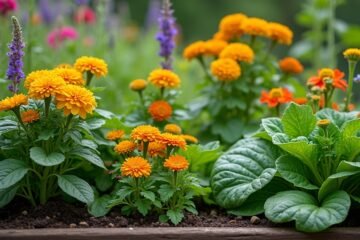Want to supercharge your veggies? Flower friends are here to help! Marigolds, with their vibrant blooms, are like tiny pest bouncers, pushing away bugs. Nasturtiums act as flashy decoys for aphids, drawing them in while your veggies thrive. Borage? It’s your tomato’s best buddy, attracting bees for better pollination and tastier fruit. It’s like inviting a parade to your garden! Stick around to discover more about these colorful allies and how they can transform your green space!
The Benefits of Companion Planting
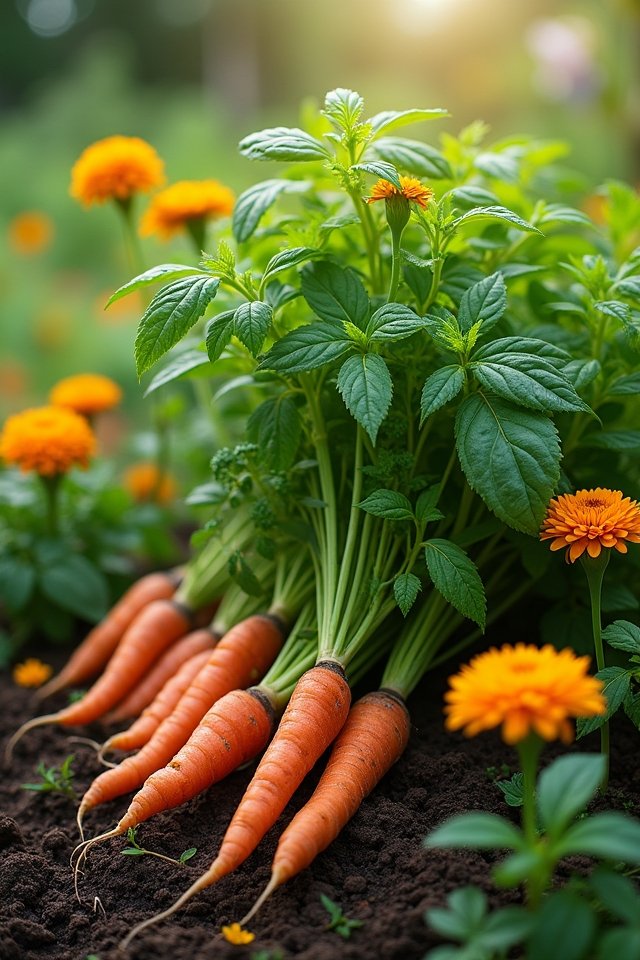
Have you ever wondered how some garden veggies seem to thrive while others struggle? It all comes down to the magic of companion planting! By pairing certain plants together, you not only enhance soil health but also boost your harvest. Envision this: tomatoes and basil dancing in the same bed, with basil repelling pests and improving tomato flavor. It’s like a garden party!
Implementing crop rotation keeps your soil rich and ready for the next season, preventing pesky pests from moving in. Imagine rotating your crops like a well-organized dance routine, ensuring each veggie gets its spotlight. With these innovative methods, your vegetable garden can flourish like never before! Who wouldn’t want a veggie haven brimming with health and flavor?
Marigolds: The Pest Deterrent
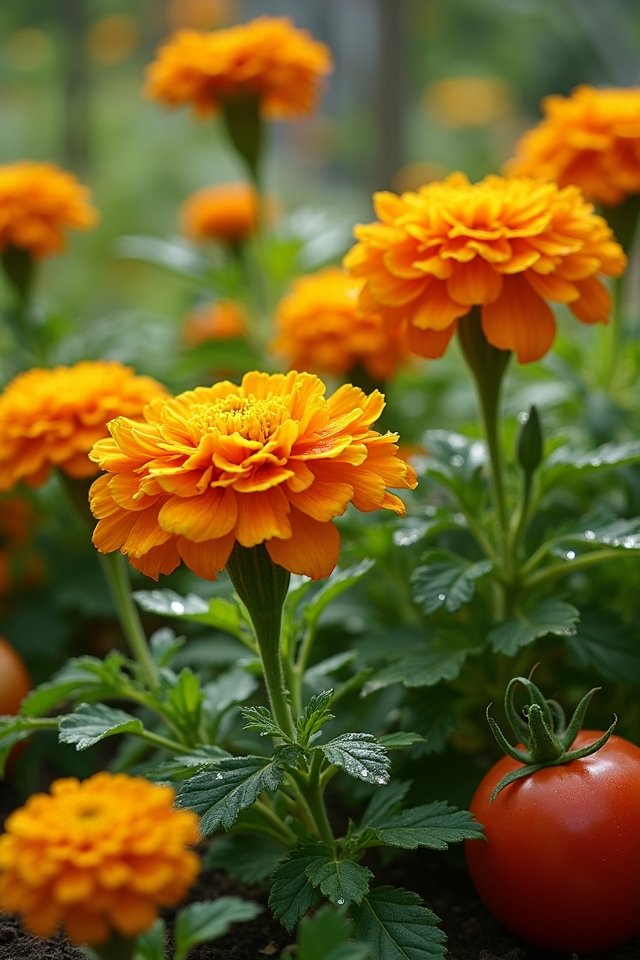
While you may not think of flowers as your garden’s secret weapon, marigolds are truly the little champions of pest control! These vibrant blooms aren’t just pretty faces; they’re powerful pest repellents, ready to defend your veggies. With various marigold varieties, like the classic French and the lovely African, you can turn your garden into a fortress against hungry pests. Envision this: you plant marigolds among your tomatoes, and those pesky aphids take one look, then shriek and flee! Isn’t that cool? Their unique scent confuses harmful insects, making your plants the safe haven they crave. So, bring on the marigolds! Watch your garden thrive and say goodbye to unwanted visitors—it’s time to release your floral guardians!
Nasturtiums: A Trap Crop for Aphids
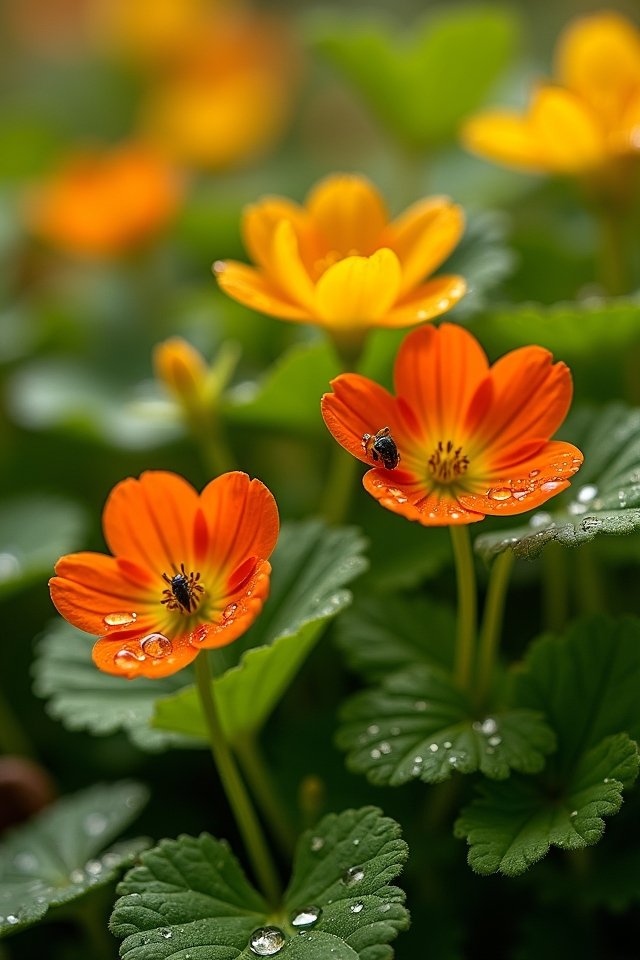
If marigolds are your garden’s fearless guardians, then nasturtiums are the clever decoys that lure aphids away from your beloved veggies! These vibrant, peppery delights don’t just add color; they practically roll out the red carpet for those pesky pests. With their enchanting flowers, these plants work magic in your garden. As aphids flock to them, they leave your precious crops safe and sound, boasting impressive nasturtium benefits!
Imagine planting a patch of cheerfully blooming nasturtiums, creating a tiny paradise that draws aphids like moths to a flame. You’ll be left marveling at how your tomatoes, beans, and lettuces thrive—unscathed and beautiful! Why not give it a try? Your plants will thank you!
Borage: A Boost for Tomatoes
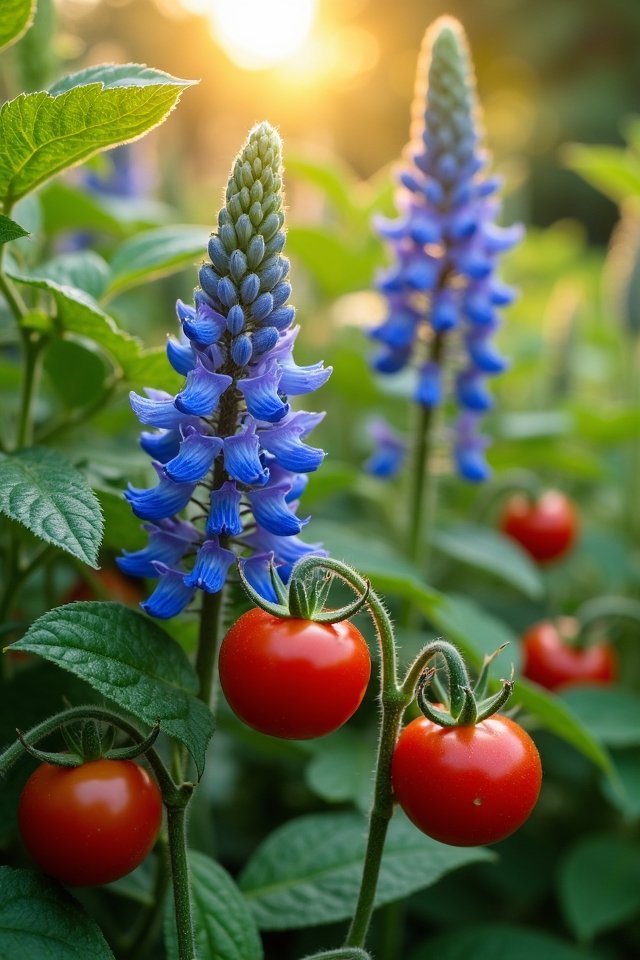
When you’re looking to give your tomatoes a tasty boost, borage might just be the secret ingredient you’ve been missing! This vibrant blue powerhouse not only dazzles your garden but also offers incredible borage benefits. With its ability to enhance pollination, it attracts bees like a magnet, which means more fruit for you! Plus, borage helps combat pests and may even improve your tomatoes’ flavor—who wouldn’t want that?
Caring for borage is a breeze, just plant it in well-drained soil and watch it thrive! You’ll enjoy its lush foliage while knowing it’s working hard to support your tomato plants. So, why not give borage a try? Your taste buds will thank you, and your garden will be a thriving paradise!
Calendula: Attracting Beneficial Insects
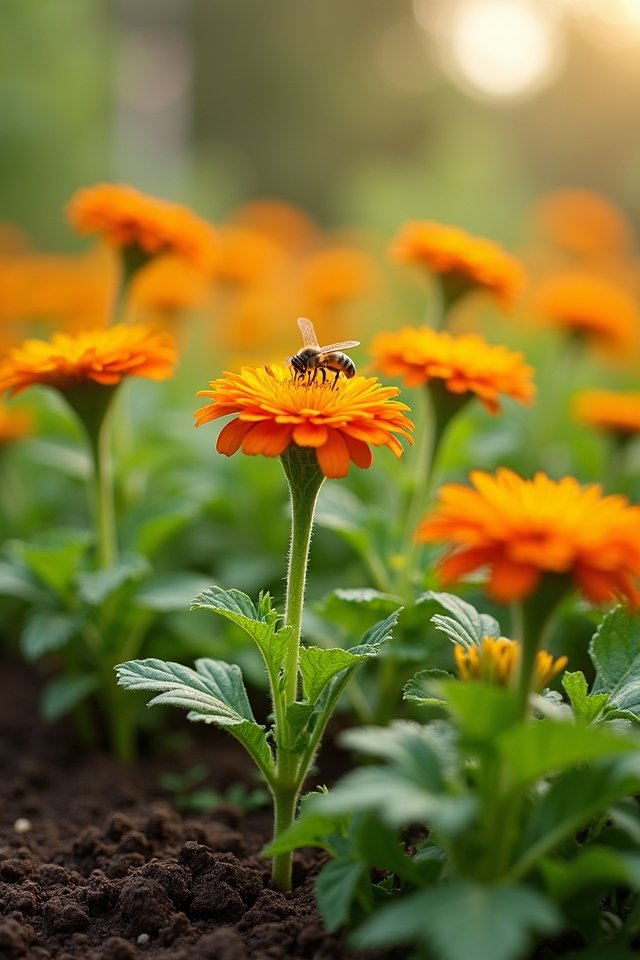
As you nurture your lush tomato plants with borage’s help, don’t forget about another remarkable companion: calendula! This vibrant flower not only brightens your garden but also plays a significant role in attracting beneficial insects. Who wouldn’t want a little extra help in the veggie patch?
Here are three calendula benefits that’ll excite you:
- Pollinator Magnet: Its nectar draws in bees and butterflies, buzzing joyfully around your plants!
- Pest Control: Calendula can deter harmful pests, giving your veggies a safe haven.
- Beauty Boost: Its cheerful orange and yellow blooms add a pop of color to your garden!
Trust me, calendula’s all about creating a lively ecosystem, helping your tomatoes thrive in a fabulous, flourishing garden!
Zinnias: Colorful Allies for Pollinators
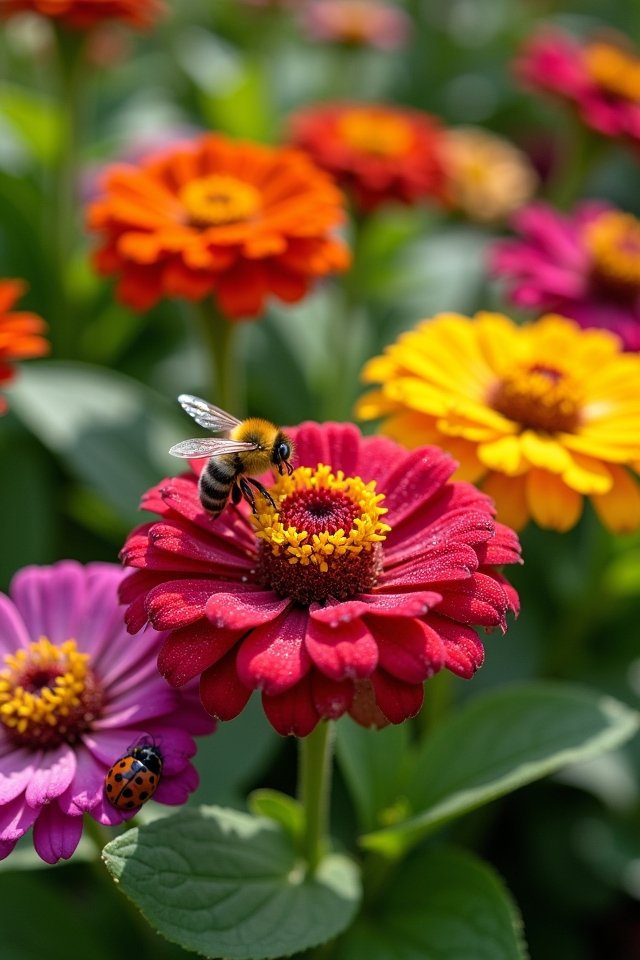
Zinnias are like vibrant fireworks in your garden, bursting with color and life! These stunning blooms not only catch your eye, but they also attract a multitude of pollinators. With various zinnia varieties, from the tall and majestic to the petite and charming, you’ve got a lot of options to play with. Are you ready to entice butterflies and bees with your zinnia patch? You’ll discover that their pollinator preferences lean heavily toward the bright hues of zinnias, drawn in by the sunshine-like shades. Picture your garden hosting a lively dance of winged friends, sipping nectar. Plant zinnias in your veggie patch, and watch how they work their magic—creating a buzzing symphony while boosting your harvest!
Sunflowers: Tall Protectors for Smaller Crops
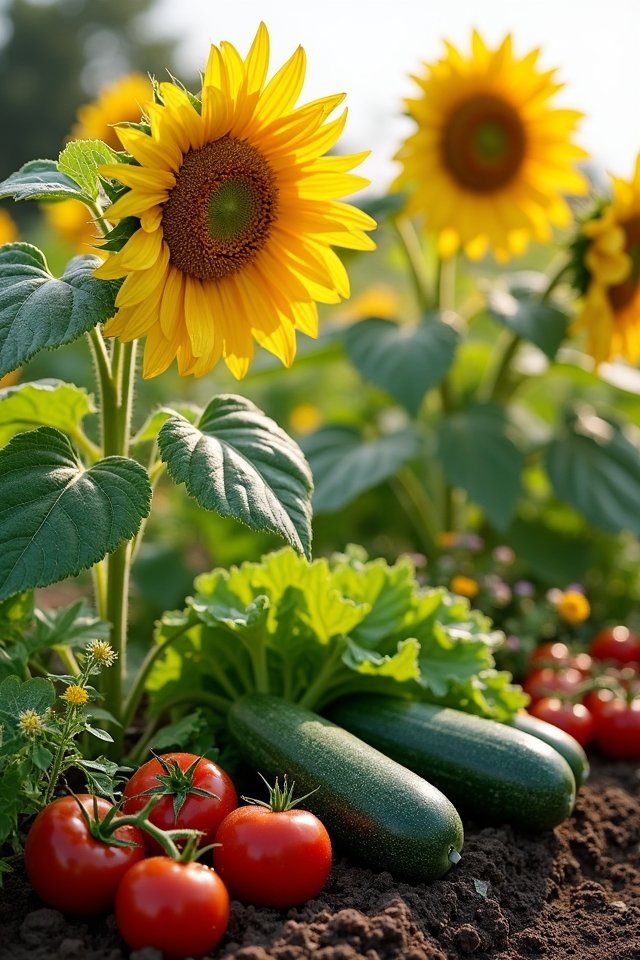
Have you ever noticed how sunflowers tower over other plants, standing like sentinels in your garden? These vibrant sentinels are not just pretty faces! They offer incredible benefits, especially for your smaller crops.
Here’s how you can utilize different sunflower varieties as protective partners:
- Shade: Sunflowers can shield tender plants from harsh afternoon sun, helping them thrive.
- Support: Their impressive crop height acts like a natural windbreak, reducing stress on fragile veggies.
- Pest Control: By attracting beneficial insects, you’ll minimize pests that target your veggies.
Planting sunflowers could transform your garden into a flourishing oasis. Imagine lush greens under those yellow giants, dancing in the breeze! So, why wait? Welcome these tall protectors today!
Sweet Alyssum: A Floral Ground Cover
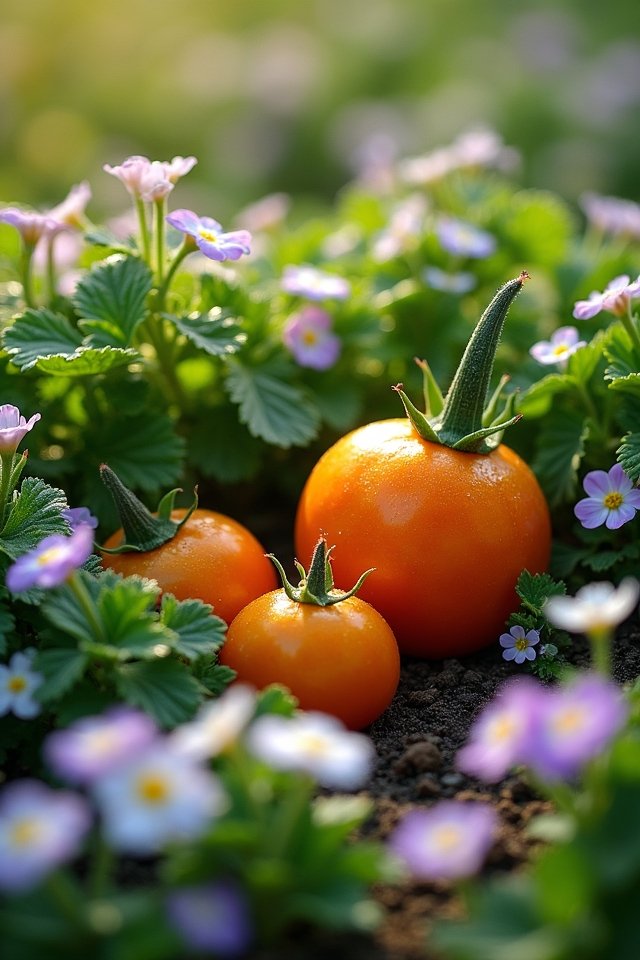
Imagine a vibrant carpet of flowers that welcomes you into your garden! Sweet alyssum isn’t just pretty; it’s a powerhouse for health! These delightful blooms offer sweet alyssum benefits like attracting pollinators and repelling pesky pests. Picture butterflies dancing around while beneficial insects munch on aphids.
Caring for your sweet alyssum is a breeze! Just give it well-drained soil and a sprinkle of water. Deadheading helps to keep those flowers coming, giving you a non-stop show. And if you sprinkle some seeds, they’ll self-sow and keep spreading joy! So, why not let sweet alyssum be your garden’s charming sidekick? Its fragrance literally kisses the air, creating an irresistible atmosphere. Trust me, you’ll be enchanted!
Insights for Designing a Companion Flower Garden
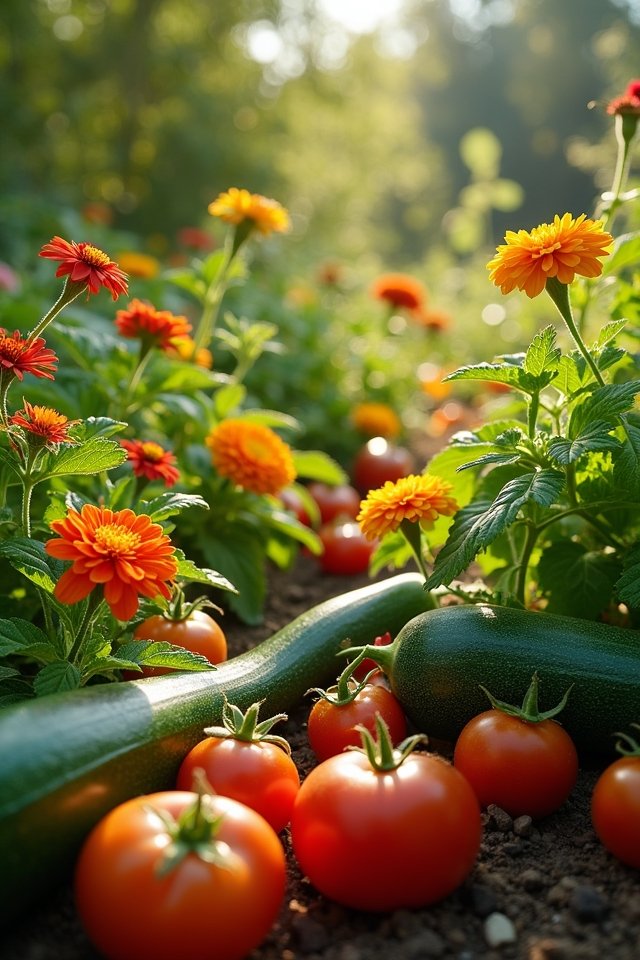
Creating a companion flower garden can feel like throwing a vibrant dance party in your backyard! With the right flower selection and garden layout, you can invite beneficial bugs and dazzling colors to your space. Here’s how to keep the party going:
- Choose bold blooms: Opt for marigolds to ward off pests or vibrant zinnias for butterflies—nature’s guests love a good show!
- Plan your layout: Group flowers by height and color for a stunning visual impact. Shorter flowers in front and tall ones at the back create depth, like an engaging performance!
- Mix and match wisely: Introduce flowers that attract pollinators alongside your veggies—it’s like having your cake and eating it too!
Now, let the flower fiesta begin!
Frequently Asked Questions
Can Companion Flowers Grow in Containers With Vegetables?
Absolutely, you can grow companion flowers in containers alongside your vegetables! Imagine vibrant marigolds brightening up your tomato plants while keeping pesky pests at bay. Container gardening’s flexibility lets you mix colors and scents, enhancing your garden’s beauty and attracting beneficial pollinators. Plus, those flowers boost your veggies’ growth, acting like cheerleaders! So why not add some zesty nasturtiums or cheerful petunias? It’s a win-win for your palate and your garden’s personality!
Are There Flowers That Should Not Be Planted With Vegetables?
Did you know that certain flowers can actually hinder vegetable growth? Yup, some incompatible flowers can just be troublemakers! For instance, plants like *marigolds* may love companionship, but *larkspur* can be toxic to veggies. If you want your garden to flourish, steer clear of these controversial blooms! Think of it this way: you wouldn’t invite a party crasher to your potluck, right? Keep your veggie friends safe and thriving! Let the harmony begin!
How Do I Choose the Right Flowers for My Garden?
Choosing the right flowers for your garden can feel like picking a new outfit—colorful blooms that match your vibe are essential! Think about seasonal selections: sunflowers bring joy in summer, while asters dazzle in fall. Imagine those vibrant petals dancing in the breeze! Try pairing marigolds with veggies; they repel pests! Just remember, balance is key. So, what flowers fire up your imagination? Let’s make your garden a breathtaking masterpiece!
What Is the Best Planting Distance Between Vegetables and Companion Flowers?
Did you know that planting flowers and veggies together can increase your garden yield by up to 20%? For ideal plant spacing, keep your companion flowers about 12 to 18 inches apart from the vegetables. This helps maximize sunlight and airflow, creating a symphony of growth in your garden design! Think of it as a dance party where everyone has their space to shine! So, make room for both—your produce and flowers will thank you!
Can I Use Seeds From Companion Flowers to Grow Next Season?
You can use seeds from companion flowers to grow next season, but keep an eye on seed viability. Some flowers, like zinnias and marigolds, thrive when harvested and planted again! Just make certain your flower selection is suited to your climate and soil. It’s like planting a treasure map, leading you to a vibrant garden of color and life. Who doesn’t want to dig up beauty while boosting their veggie pals? Exciting, right?
